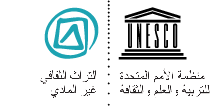Traditional art and symbolism of Kelaghayi, making and wearing women’s silk headscarves (جاري عملية الترجمة)
سجل في (9.COM) على القائمة التمثيلية للتراث الثقافي غير المادي للبشرية
بلد(ان): أذربيجان
تعريف
Description

- Traditional art and symbolism of Kelaghayi, making and wearing women’s silk headscarves
- © 2010 by M.Rahimov/Ministry of Culture and Tourism
عذراً، هذه الصفحة غير متوفرة باللغة العربية
Rooted in traditions found along the Great Silk Road, the art of Kelaghayi is concentrated in two locations in the Republic of Azerbaijan: the city of Sheki and the Basgal settlement. Kelaghayi making consists of several stages: fabric weaving, dyeing and woodblock decoration. Weavers choose thin silk threads from sericulture producers and weave fabrics on looms and then boil and dry them to make square-shaped cloths. Using vegetable substances, masters then dye the cloths various colours and decorate them with patterns using wooden stamps, covered with solutions made from rosin, paraffin and solid oil. The colours of headscarves have symbolic meanings and are often tied to specific social occasions, such as weddings, mourning ceremonies, daily activities and celebrations. The art of Kelaghayi making is transmitted through non-formal apprenticeship only, and is primarily a family occupation. Each family has its own stylistic features and patterns of decoration. The traditional practice of making and wearing headscarves is an expression of cultural identity and religious traditions and a symbol of social cohesion, reinforcing the role of women and strengthening the cultural unity of Azerbaijani society.مستندات
عرض الشرائح
فيديو
© Asif Abramov, 2011
يمكن استعراض مقاطع الفيديو هذه (بالإضافة إلى العديد غيرها) من خلال موقع أرشيف اليونسكو للملتميديا”











